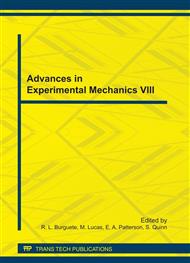[1]
JE Arsenault, M Mora-Plazas, y Forero, Provision of a school snack is associated with vitamin B-12 status, linear growth, and morbidity in children from Bogota, Colombia e nutrition, J. Nutr. September, vol. 139, No. 9, p. pp.1744-1750. (2009).
DOI: 10.3945/jn.109.108662
Google Scholar
[2]
David P. Cappelli, Connie C. Mobley, Prevention in clinical oral health care, Elsevier Health Sciences, p.49. (2008).
Google Scholar
[3]
Discacciati de Lértora, S; Matínez de Meyer, L Primer Molar permanente: Riesgos y afecciones en sus primeros años, Revista FOUNNE. Nº 2, p. pp.23-28 (1994).
Google Scholar
[4]
Serra, M.D., Gambareli, F.R. and Gavião, M.B. A one-year intra-individual evaluation of maximum bite force in children wearing a removable partial dental prosthesis. J. Dent. Child (Chic) 74, 171 – 176. (2007).
Google Scholar
[5]
Al Shalan, Thakib A.; Al Askar, Amal, In vitro effect of different concentrations of iron on the initiation of dental caries: pilot study. King Saud University - College of Dentistry, SDJ - Saudi Dental Journal [The]; 18 (2): 86-90 (2006).
Google Scholar
[6]
Paphangkorakit J, Thothongkam N, Supanont N. Chewing-side determination of three food textures. J Oral Rehabil; Vol. 33, p. pp.2-7. (2006).
DOI: 10.1111/j.1365-2842.2006.01535.x
Google Scholar
[7]
Olthoff LW, Van der Bilt A, De Boer A, Bosman F. Comparison of force-deformation characteristics of artificial and several natural foods for chewing experiments. J Texture Stud; 17: 275-289. (1986).
DOI: 10.1111/j.1745-4603.1986.tb00553.x
Google Scholar
[8]
Hernández-Gómez, Luis-Hector; Urriolagoitia-Calderon, Guillermo; González-Rebatú, Alejandro; Urriolagoitia-Sosa, Guillermo; Galán-Vera, Manuel-Mauricio; Escalante-Rodríguez, Enrique, Assessment of the Structural Integrity of C3-C5 Cervical Porcine Vertebrae Model based on 2-D Classic CAD, 3-D Scanner and 3-D Computed Tomography, Mechanics of Biological Structures, Springer in Germany. (2011).
DOI: 10.1007/978-3-642-22131-6_1
Google Scholar
[9]
Howell AH, Brudevold F., Vertical forces used during chewing of food, J Dent Res 29: 133-136. (1950).
DOI: 10.1177/00220345500290020401
Google Scholar
[10]
John D. Rugh and William K. Solberg, The measurement of human oral forces, Behavior Research Methods, Volume 4, Number 3, 125-128, DOI: 10. 3758/BF03207846. (2011).
Google Scholar
[11]
V.K. Goel, S.C. Khera, J.L. Ralston, K.H. Chang. Stresses at the dentin enamel junction of human teeth-a finite element investigation,. Journal of Prosthetic Dentistry. Vol. 66, p. pp.451-459. (1991).
DOI: 10.1016/0022-3913(91)90504-p
Google Scholar
[12]
H.E. Lee, C.L. Lin, C.H. Wang, C.H. Cheng, C.H. Chang. Stresses at the cervical lesion of maxillary premolar - a finite element investigation,. Journal of Dentistry. Vol. 30 Nº 7-8, p. pp.283-290. (2002).
DOI: 10.1016/s0300-5712(02)00020-9
Google Scholar
[13]
L.G. Selna, HT. Shillingberg, PA. Kerr. Finite element analysis of dental structures – axisymmetric and plane stress idealizations,. Journal of Biomedical Material Research. Vol. 9, p. pp.237-252. (1975).
DOI: 10.1002/jbm.820090212
Google Scholar
[14]
Patricio Cendoya1 Jorge Hernández, Emilio Dufeu1, COMPUTER ANALYSIS OF NON-CAVITY CERVICAL LESIONS IN AN UPPER PREMOLAR, Ingeniare. Revista chilena de ingeniería, vol. 15 Nº 2, pp.169-173. (2007).
Google Scholar
[15]
Photoelastic Division Measurements Group: Photoelastic Materials. Bulletin: S-116-H. Measurements Group Inc, Raleigh. (1996).
Google Scholar


